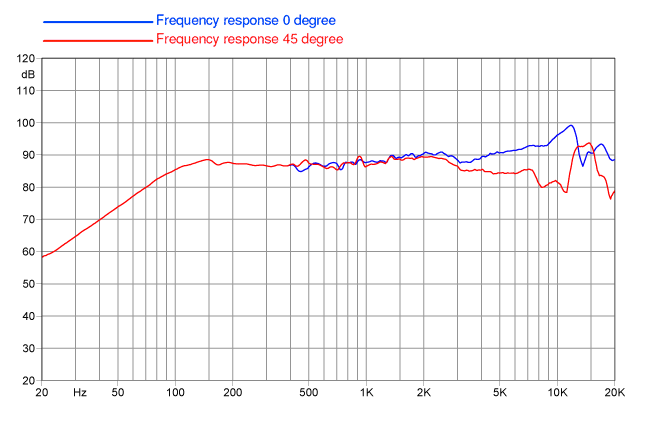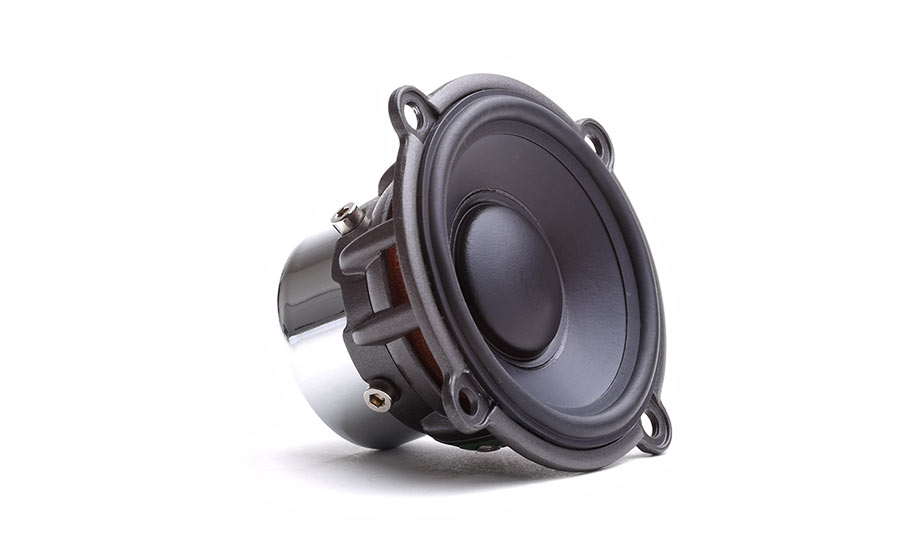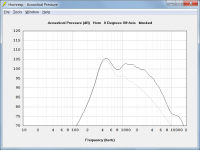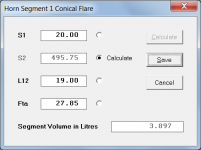Hey!
This is my first attempt at building Synergy horn. And first attempt at modelling it as well
Initially, i was going to replicate the xBush build. but couldn't find the parts the guys used in the build including the horn. So i decided to find the one with similar specs.
P-audio PH-642 seems like a good candidate. It will fit into a box the size of which i am going to tolerate and is of similar dimensions to 18 Sounds or Faital horn from the original design:

I decided to go with pro drivers in this design. Mids are Beyma 8G40 and for the widebander i am going to use Faital 3FE25. For some reason, the acoustic response in Hornresp shows a rather steep high frequency roll off:



Am i doing something wrong? Or is this a clear indication that this horn is not good for this kind of setup?
I then toyed with the Synergy Calc Excel spreadsheet, generated parameters for Hornresp for the horn of similar size/length and it produced similar results.
This is my first attempt at building Synergy horn. And first attempt at modelling it as well
Initially, i was going to replicate the xBush build. but couldn't find the parts the guys used in the build including the horn. So i decided to find the one with similar specs.
P-audio PH-642 seems like a good candidate. It will fit into a box the size of which i am going to tolerate and is of similar dimensions to 18 Sounds or Faital horn from the original design:

I decided to go with pro drivers in this design. Mids are Beyma 8G40 and for the widebander i am going to use Faital 3FE25. For some reason, the acoustic response in Hornresp shows a rather steep high frequency roll off:



Am i doing something wrong? Or is this a clear indication that this horn is not good for this kind of setup?
I then toyed with the Synergy Calc Excel spreadsheet, generated parameters for Hornresp for the horn of similar size/length and it produced similar results.
For some reason, the acoustic response in Hornresp shows a rather steep high frequency roll off
That's because you are looking at the Nd record power response, not the pressure response. To get some idea of the pressure response for the Nd record in isolation, delete the second segment and change the segment 1 inputs to S1 = 20.00, S2 = 495.75 and L12 (Con) = 19.00. The attachment shows the resulting on-axis pressure response (dark trace) compared to the power response (light trace).
When looking at the performance of the complete 2-way Synergy system using the Multiple Entry Horn Wizard, only the power response is shown because multiple segments are used, and the Hornresp directivity tools are not applicable in this case.
Attachments
Hm. Interesting.
If the response your attachment remotely mirrors what i am going to get, than this is not really that ice looking Maybe i should use a CD instead.
Maybe i should use a CD instead.
How did you derive S2 = 495.75 and L12 (Con) = 19.00? Is it an average approximation to get two segment horn data?
Tried modelling MEH with the wizzard. This is what i get.



Still doesn't quite resemble your graph.
If the response your attachment remotely mirrors what i am going to get, than this is not really that ice looking
How did you derive S2 = 495.75 and L12 (Con) = 19.00? Is it an average approximation to get two segment horn data?
Tried modelling MEH with the wizzard. This is what i get.



Still doesn't quite resemble your graph.
A lot of HF are lost.
As indicated in my previous post, the MEH Wizard only shows the power response, which is why the HF seems to fall away.
How did you derive S1 = 20.00, S2 = 495.75 and L12 (Con) = 19.00?
I used the Horn Segment Wizard to extend the conical segment to the full 19 cm length of the original two-segment horn system, while retaining the original conical horn flare tangent angle of 27.85 degrees - see attachment. The two segments were replaced with one segment so that the Directivity tool could be used to give some idea of the HF performance that could be expected to be seen in practice.
Attachments
As indicated in my previous post, the MEH Wizard only shows the power response, which is why the HF seems to fall away.
A little more clarification here:
The power response is the output of the speaker taken over a full sphere. ie, the total power that the speaker is radiating into the environment.
Since horns introduce some directivity (usually moreso above 1kHz), we need to check what's happening in front of the horn to see what we're really going to get in the kHz range.
Chris
I've tried at length to get decent response from small full range drivers in a 2" throat horn with no luck. Your response will likely be more extended than modelled but will have large response aberrations that change with angle, making them impossible to eq out.
I found out the hard way that most don't work. (I bought a LOT of different ones.)

The SB Acoustics 2.5" is special. The dustcap is a soft dome, and the glue is designed so that the dustcap 'decouples' from the cone at high frequency.
An externally hosted image should be here but it was not working when we last tested it.
You can see this in the measurements. At 20khz, the SB65 is 10dB louder than at 10khz! Basically you have a fixed amount of motor force operating on a lower mass (because it decoupled) so you get this rise in the response at high frequency. To improve things even further, the SB65 has a shorting ring to lower inductance.

An externally hosted image should be here but it was not working when we last tested it.
The Faital isn't terrible by any means, but the high frequencies are nowhere near as nice as the SB Acoustics. The Faital has a conventional paper cone, it has no shorting ring, there's nothing special about the cone's construction. Comparing the Faital to the SB65 is like comparing a paper cone tweeter from the 70s to a modern soft dome tweeter.

On paper, about the only thing that give the SB65 a run for it's money is the AudioFrog GB25. I'd love to try these out but I'm too cheap.
Last edited:
SB65 isn't near as sensitive as 3FE22/25 to couple with two pro woofers in my design (Beyma 8G40).
I was considering this Peerless driver, but its sensitivity is low as well.
Maybe, after a bit of experimentation, i will decide to use SB65 and compromise sensitivity or will go with a CD that must be crossed at about 600Hz. Been contemplating on buying a pair of P.Audio BM-D740. The response curve on the graph looks kinda good:

But will probabaly start with Faital
I was considering this Peerless driver, but its sensitivity is low as well.
Maybe, after a bit of experimentation, i will decide to use SB65 and compromise sensitivity or will go with a CD that must be crossed at about 600Hz. Been contemplating on buying a pair of P.Audio BM-D740. The response curve on the graph looks kinda good:

But will probabaly start with Faital
I have the following onhand:
1) that peerless woofer
2) the SB65
3) some faital 3FE20s
I think the SB65 is the winner, but maybe I should measure some and find out
Keep in mind, the limit of a Unity horn is how much output it can produce from 10-20khz, not how much output it can produce at 1khz. In the midrange of a Unity horn, we have output to burn. Anyone can make a Unity horn that can produce 110dB at 1khz, that's a piece of cake. Producing 110dB at 10khz is difficult, and producing 110dB at 20khz is *really* difficult.
That's why Danley Sound Labs has invested so much work into Paralines and Layered Combiners. The tweeter is the weak link.
1) that peerless woofer
2) the SB65
3) some faital 3FE20s
I think the SB65 is the winner, but maybe I should measure some and find out
Keep in mind, the limit of a Unity horn is how much output it can produce from 10-20khz, not how much output it can produce at 1khz. In the midrange of a Unity horn, we have output to burn. Anyone can make a Unity horn that can produce 110dB at 1khz, that's a piece of cake. Producing 110dB at 10khz is difficult, and producing 110dB at 20khz is *really* difficult.
That's why Danley Sound Labs has invested so much work into Paralines and Layered Combiners. The tweeter is the weak link.
The power response is the output of the speaker taken over a full sphere.
For the Hornresp acoustical power chart, the above statement only holds true when Ang is specified as 4.0 x Pi.
Does it look more like what i am going to hear in the real life?
The AkAbak directivity model is relatively simple, and can sometimes produce overly-optimistic pressure response predictions.
Can you post a screenprint of the actual Hornresp input parameters window that the AkAbak script was exported from?
While playing with different simulations and trying to learn Hornresp, i decided to model the driver Patrick mentioned - SB65WBAC25-4 - in the Hornresp on a Faital LTH142 waveguide that was used by XRK in the long xBush thread.


I know that it is a tractrix horn. Using the datasheet i tried to estimate areas of the throat and mouth. The model is simplified, of course. I estimated that S1 = Sd, and then, looking at the datasheet, estimated the mouth area of an ellips.
This is how the schematic model that Hornresp produced overlaps on the diagram from the datasheet:

Pretty much on par, as i can see with my untrained eye.
So, we know, that SB widebander sounds wonderful on this waveguide from the real experience of real people.
This is what i get in Acoustical Power window:

Here is the input data:

What am i missing?


I know that it is a tractrix horn. Using the datasheet i tried to estimate areas of the throat and mouth. The model is simplified, of course. I estimated that S1 = Sd, and then, looking at the datasheet, estimated the mouth area of an ellips.
This is how the schematic model that Hornresp produced overlaps on the diagram from the datasheet:

Pretty much on par, as i can see with my untrained eye.
So, we know, that SB widebander sounds wonderful on this waveguide from the real experience of real people.
This is what i get in Acoustical Power window:

Here is the input data:

What am i missing?
Sorry, there is a large mistake in the calculations in the previous example.
I cannot edit my posts, so i am making a new one with corrections.
Here is my another attempt to estimate the response on LTH142 and compare it to a real result.
Again, knowing that the mouth of the waveguide is an ellipse, i basically split the waveguide in 5 segments and estimated the area of each segment. I tried modelling it as a single segment horn hitting the T key and then letting the program to calculate the rest, but i ended up with wrong data. Thus, i decided to split the tractrix into 5 conical segments.
Here is the result of those:



And here is how AkAbak predicts the response of this model:

I cannot edit my posts, so i am making a new one with corrections.
Here is my another attempt to estimate the response on LTH142 and compare it to a real result.
Again, knowing that the mouth of the waveguide is an ellipse, i basically split the waveguide in 5 segments and estimated the area of each segment. I tried modelling it as a single segment horn hitting the T key and then letting the program to calculate the rest, but i ended up with wrong data. Thus, i decided to split the tractrix into 5 conical segments.
Here is the result of those:



And here is how AkAbak predicts the response of this model:

What am i missing?
You seem to be missing what we've been telling you.
HF horns impose some directivity in the high-frequency region.
Akabak is simulating directly on-axis with the horn.
Hornresp is simulating the power response - that's the total output collected over all angles. Since the horn will have a ~flat response on-axis (ie, there'll be less treble to the sides and rear), the power response drops towards the treble.
You're not comparing apples to apples, so it should be no surprise that the results are different.
Chris
Akabak is simulating directly on-axis with the horn.
Hornresp is simulating the power response - that's the total output collected over all angles. Since the horn will have a ~flat response on-axis (ie, there'll be less treble to the sides and rear), the power response drops towards the treble.
This made it clear. Thank you.
Ok, how do i make decisions based on Hornresp or AkAbak simulations?
BTW, if my model of LTH142 horn is roughly correct, it still doesn't quite correlate with the real world result (SB Acoustic mid on LTH142 in Xrk's speaker):

P.S. These questions may seem stupid and i even guess they are
I've tried at length to get decent response from small full range drivers in a 2" throat horn with no luck. Your response will likely be more extended than modelled but will have large response aberrations that change with angle, making them impossible to eq out.
As for this consideration - will i be better off, if i install the widebander using this kind of adapter, to tighten the widebander's sound into a smaller spot before it goes into the waveguide?

Here are the inputs:
Thanks.
Here is the resulting graph with default parameters in AkAbak (just clicking SPL -> OK):
The AkAbak results look almost too good to be true
- Status
- This old topic is closed. If you want to reopen this topic, contact a moderator using the "Report Post" button.
- Home
- Loudspeakers
- Multi-Way
- Will this horn work in a 2-way Synergy?




